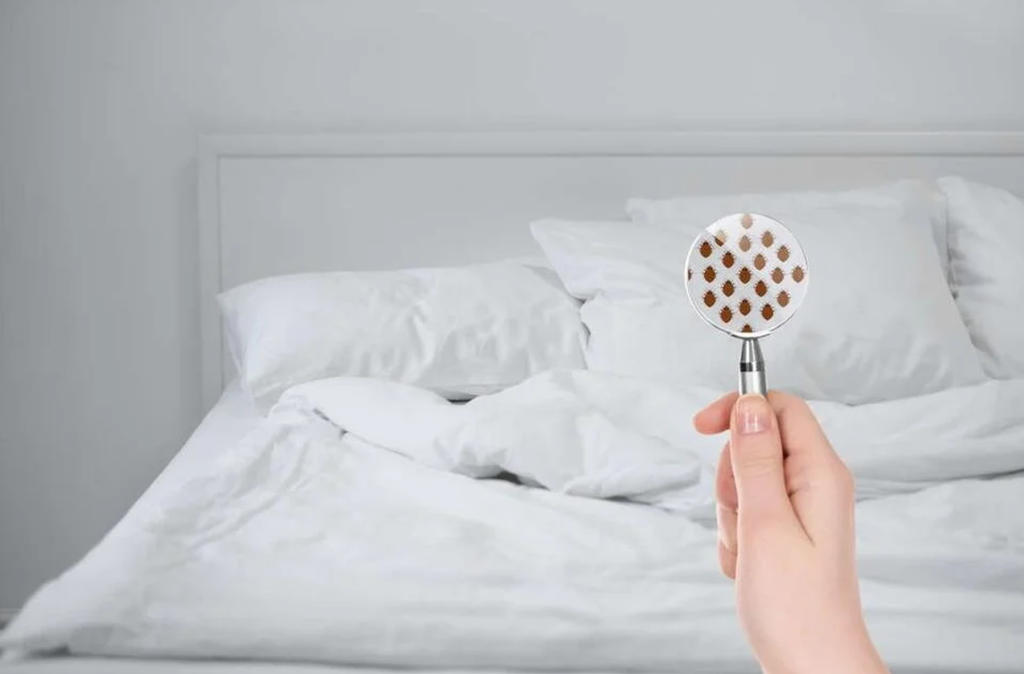
Looking for the best way to get rid of bed bug infestation? You are in the right place.
The nasty pests are becoming more populated in the United States, and people are now looking for effective and eco-friendly ways to capture them with bed bug traps. But do bed bug traps work? And how efficient are they?
The short answer would be that bed bug traps are a great tool to use if you want to monitor and control the population of bed bugs in your home. But, you will most likely need a lot of other tips and tricks if you want to eliminate the bugs completely.
So, if you are ready to find bed bug traps that work, keep on reading. You will have a bug-free and beautiful home in no time if you follow our simple guide.

What Are Bed Bug Traps?
Before we discover how effective are bed bug traps we have to go over the basics and get familiar with the terminology used. This way, you can be sure you are choosing the best bed bug trap for your needs and your home.
Bed bug traps are designed to attract, collect and kill bed bugs depending on the trap and the purpose.
Infestation with bed bugs can begin with just a few small bites or even a single female specimen and get out of control in a few weeks. Because bed bugs multiply rapidly and because they are very skilled at hiding, it’s practically impossible to determine if you have any unwanted visitors in your home.
Most people notice a few red marks and bites in the morning and often overlook the problem until the infestation is severe. So, if you want to avoid dealing with harsh chemicals or spending your money on professional exterminators, you can use a few traps to help the problem.
Traps are going to reduce the number of bites and allow you to determine the size of the infestation. So, while you get a good night's sleep, you will also be able to decide on the next best step in your fight against bed bugs.
Types of Bed Bug Traps
Depending on your home and the severity of the infestation with bed bugs, you might want to look into different types of bed bug traps. Each one is designed to lower the number of bugs and allow you to assess the effectiveness of other methods you are using.
Here are some of the most typical bed bug traps on the market:
Bed Bug Interceptor Traps
Interceptor traps are the best bed bug traps for bed legs and one of the finest ways to protect your bed from infestations. The simple concept behind this tool is based on the fact that bed bugs are not good climbers.
The plastic pitfall trap is placed under the bed legs, where the bugs climb to feed during the night. The bed bugs are able to come out of their hiding places and climb into the interceptor trap, but because the inner walls of the trap are smooth, bugs are not able to leave.
Interceptor traps are a fantastic solution for people who want to monitor the infestation and see if there are any bed bugs present in the home. Considering they are made from high-quality plastic, you can use the interceptor traps repeatedly.
The interceptors are entirely eco-friendly and don’t have any pesticides in them. This way, you can be sure your family is safe, but on the other hand, you will need to dispose of the captured bugs by yourself. You can do this with warm, soapy water or outside the residence to prevent re-infestation. Just make sure to clean the traps occasionally and be careful that bugs don’t escape from the pitfall while you empty it.

Keep in mind that the new species of a pest called tropical bed bug (Cimex hemipterus) is a better climber. The legs of this kind of bug have more hairs, and they produce a sticky residue enabling them to climb smooth surfaces with ease.
While most homes in the US have the common bed bug (Cimex lectularius), some new research shows the difference between the species and the effectiveness of traps such as interceptors.
Bed Bug Lures
Bed bug lure and trap work on the assumption that those nasty pests are drawn in by our body heat and the carbon dioxide (CO2) we produce while breathing. The lures use different chemicals to mimic a human and attract the bed bugs into the trap.
Some of the lures have glue inside to ensure all the captured bugs have nowhere to go, while others simply detain the bugs that are drawn in.
This is one of the best bedbug traps if you want to check the severity of the infestation, but on the other hand, the scent that the lure produces can be strong enough to attract bugs from other apartments. It’s best to use this type of trap in conjunction with other tools to help you assess and manage the infestation in the best way possible.
It’s also recommended to use a lure trap when you want fast results or when you are staying in a hotel room and want to be sure there are no bugs present.
Bed Bug Glue Traps
Bed bugs are flat and small insects that can hide practically everywhere, and it’s not uncommon to hear that people dealing with infestations never saw a bug. This is why traps that contain glue surfaces can come in handy.
You can place bed bug sticky traps all around your home and in places where the pests are more likely to hide. This can include the floors around the bed, furniture, carpets, and other surfaces you might find the bed bugs passing through.

The high-quality glue will last a long time and capture all the bugs, whether they are the new tropical or common bed bugs. By checking in on glue traps occasionally, you will be able to determine the severity of the infestation and reduce the number of bites you get each night.
If you go for the right brand of bed bug glue traps, you can be sure they are completely safe, eco-friendly, and contain no harsh chemicals or pesticides.
DIY Traps
Considering how bothersome and persistent bed bugs can be, some people opt for homemade remedies to help with the infestation. DIY traps include lure traps created with yeast and sugar to produce the CO2 or simple sticky tapes that aim to capture the little pests.
While home-crafted solutions can help you reduce the number of bed bugs, they can be pretty messy and unreliable. The DIY solutions alone are not efficient enough to eliminate bugs in all stages and from all the places they might be hiding.

How Do Bed Bug Traps Work?
You might be wondering: “But how do bedbug traps work?” Depending on the trap you have chosen, they can work in different ways.
In case you set up bed bug interceptors or glue traps, you can expect the bugs to get stuck in the trap when they are relocating to feed. This usually happens during the night, so you might have to wait at least 24 hours before noticing any bugs in your trap.
The basic design of interceptors and glue traps is based on the notion that bed bugs must emerge from their hiding locations to feed. Unfortunately, because they exclusively feed on blood, you will be their next meal. When the bugs become hungry enough, they will emerge from their hiding spots and make their way to your bed, where they will be caught by the traps.
On the other hand, if you set a lure trap, the scent and CO2 emitted can draw out the bed bugs sooner. These little devices mimic the presence of a human and attract the hungry bugs right into the trap. Most lures on the market also contain a thin layer of glue to trap the bed bugs, so they don’t leave.
How Fast Do Bed Bug Lures Work?
If you choose to go with the bed bug interceptor or the glue traps, you might have to wait for a day or two to see the results. This will give the trap enough time to work and capture all the hungry bugs heading your way.
Lure traps might work a bit faster and deliver the results in a few hours, and this is one of the reasons why they are so effective when you want to check a place like a hotel really quickly before you settle.

Are Bed Bug Traps Effective?
Now that we are familiar with all of the details about different traps and bed bugs in general, we can answer how effective are bed bug traps and if they really work. The best answer would be yes; the traps are effective and work amazingly with controlling the infestation and assessing the current state of your home.
On the other hand, the traps are helpful with ending minor infestations within a few days, but it might take a few more tips and tricks if you are dealing with a large number of bed bugs in your house.
So, the best way to use any kind of bed bug trap is in conjunction with other methods that will eliminate the pests completely. The traps will reduce the number of bites you get, improve the quality of your sleep, and allow you to assess the effectiveness of other methods you might be using.
Let’s see how effective each bed bug trap is:
Interceptor Traps
It’s often the simplest things and tools that deliver the best results. This is one of the reasons why so many people invest in high-quality interceptor traps. They are easy to install and capture all the bugs that try to climb the bed, and you can use them over and over again.
Considering they are made out of plastic and contain no pesticides, they are not only a safe but durable way to manage pests in your home.
Keep in mind that you need to declutter your room if you want your interceptors to work.
This can include removing all the things under your bed, making sure the bed frame is not touching the wall, and bedding is not in contact with other surfaces. When the legs of the bed are the only way up, bugs will most likely enter the interceptor and get stuck in the well.
If you have the tropical bed bugs, you won’t be able to tell the difference with your naked eye, but you will notice they can easily escape the interceptors. When dealing with this kind of infestation, you will need additional tools to manage the bed bugs.
Lure Traps
Lure traps might be a good solution if you want to assess the infestation fast.
This type of trap is not passive and emits pheromones, CO2, or similar compounds to attract the bugs. This can be a good solution for some places, but on the other hand, the chemicals used need to be in perfect balance to attract only the bugs in your home and not the ones your neighbor has.

Glue Traps
Sticky traps are a great way to quickly assess the infestation and reduce the number of bugs in your bed and home. The traps are easy to use, and they don’t contain any chemicals that might harm your family or attract bugs from other places.
While they might not be enough to eliminate all the bugs, they are effective in smaller infestation cases and work fantastic as a management tool. You will be able to capture and see all the bed bugs, assess the severity, and dispose of the captured pests quickly.
DIY Traps
As much as DIY traps look affordable and practical, they are rarely effective.
People who use yeast and sugar to attract the bugs need to be extra careful with the proportions. It might not be harmful, but it can get messy fast.
On the other hand, you might hear the advice to use simple tape as glue traps, but this will not capture the bugs. The pests usually avoid such pitfalls or simply escape because the glue is not strong enough.
When it comes to persistent and large infestations, it’s better to invest in high-quality products with proven efficiency rather than making your tools. You will save a lot of money and your health if you choose the suitable methods from the start.
How to Eliminate Bed Bugs Completely?
Even the best bug trap will work better if you add a couple of more methods to eliminate the bugs completely. You need to take specific steps to kill the existing bugs, destroy all the potential hiding places, and prevent re-infestation.
Now that we know how to use bed bug traps, we can focus on additional layers of protection.
Here is what you need to do:
If you notice red bites on your skin, blood spots on your sheets, or rusty residue on the floor and walls, you are most likely in the middle of a bed bug infestation. The first thing you need to do is thoroughly clean everything.
This should include washing your sheets, vacuuming the bed, and decluttering the bedroom. In the laundry basket, you should also include all the towels and clothes that might be contaminated.

For the best results, you need to use higher temperatures and the addition of a laundry additive specially formulated to kill all the bed bugs. This will help reduce the number of bugs, eggs, and all the residue they leave behind.
While washing your clothes and sheets will kill some of the bugs, you need to remember that they are small and flat insects that could be hiding in different places. This is why you need to spray all the surfaces with specialized bed bug sprays.
The formulation is completely safe for you and your family members, but it’s deadly for bed bugs.
This will eliminate any specimens living in the mattress, carpet, and little holes in the walls. In addition to washing everything, this is one of the best ways to reduce the number of bed bugs and ultimately eliminate them over time.
Once you are sure there are fewer bed bugs and follow the instructions recommended above, you can focus on details and prevention of re-infestation. This step is a simple yet effective way to decrease the chances of bed bugs appearing again.
Keep in mind that only one female specimen left behind can start the infestation all over again, so make sure to follow through with the plan and eliminate all the bugs.
Once you have cleaned everything with the laundry detergent and specialized spay, you can add another layer of protection to your mattress and pillows. The protective sheets will enable bugs from coming into the bed while offering you a comfortable sleep.
If you want to be sure there is no hiding place in your home, you can seal all the cracks in the walls and dust non-toxic and non-poisonous diatomaceous earth (DE) natural dusting spray. With the help of the efficient duster, you can reach all the crevices and easily apply the diatomaceous earth to repel the pests.
This is also an excellent opportunity to place the interceptors under your bed to ensure there are no bed bugs left in the house.

Final Thoughts
Bed bug bed traps are an effective way to monitor and control the pest infestation in your home. Many eco-friendly options on the market, such as bed bug interceptors and glue traps, will offer the best results without using any harsh chemicals or pesticides.
While it’s essential to get rid of the bed bugs fast, you need to take into consideration the environment and the health of your family. This is why you need to choose only the non-toxic options that deliver results without harming you.
Keep in mind that while traps might be efficient, you need to ensure complete bug elimination if you want to create a beautiful and safe home. With different pest control solutions, you can ensure all the insects in your home are safely managed and out of your way.







